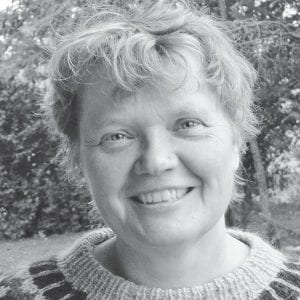Anne Marie Nielsen of Denmark has a passion for textiles and sees our human love of colors as a global heritage shared across cultures. She has spent years studying and teaching Nordic textile work to students of all ages. The lead textile instructor at Fosen Folk School in Norway from 1997-2002, Anne Marie led students in a wide variety of historic textile projects involving old techniques including vadmal sail cloth, traditional clothing, and dying with woad or other natural materials.
Prior to teaching at Fosen, Anne Marie worked in Tanzania, teaching weaving with the Ifakara Women Weavers Association. She has recently completed a study of traditional and modern tailoring at Sätergläntan, the leading craft school in northern Europe and continues to study at Raulands Academy and other course centers through Scandinavia.
When she isn’t busy with textiles, Anne Marie tells stories and has graduated as a storyteller from the International School of Storytelling in England. She is teaching three courses at North House during this, her first trip to the United States.
Well versed in many textile and fiber techniques, Anne Marie will focus on teaching three different skills while she is here: twined knitting, nålbinding mittens and socks, and dyeing with woad. Maybe the most unique or uncommon of that trio is dyeing with woad. Anne Marie says, “If you don’t know about woad, when you see it, you might think that it is just a kind of garden weed with its big green leaves, but the plant holds many secrets in those leaves. It might not be a plant that you would grow to beautify your garden, but consider this: for centuries, that plant was the only source of blue dyestuff for textiles in Europe.”
“Woad has been used for centuries and remnants of it have been found as early as the 9th century and following the discovery of the seaway to India, great amounts of indigo were imported to Europe from Asia. In some European countries laws were passed to protect the woad industry from the competition of indigo, but little by little the Asian indigo out-competed woad. The last commercial harvest of woad until recent times occurred in 1932 in Britain.”
As one of the few natural ways to create a blue dye, woad has created its own history-rich niche in the fiber world. Want to learn more? It’s best to learn about this extraordinary plant from Anne Marie herself.
Anne Marie is the featured instructor during the Annual Wooden Boat Show and Summer Solstice Festival, June 22-24. More information and the full event schedule can be found at www.northhouse.org.



Loading Comments